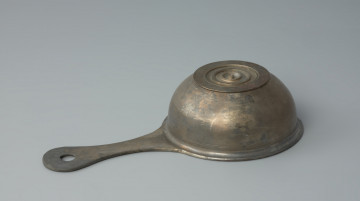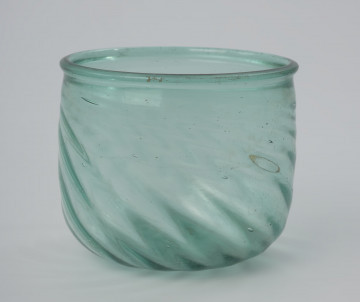
Decorated goblet
National Museum in Szczecin
Part of the collection: Antiquity
The exact place and time of finding the bronze bowl are unknown. It was probably an object from an inhumation grave. The bowl was given to the Museum in Szczecin after being inherited from Gottfried von Bülow deceased in 1907 - a historian and archivist from Szczecin, who served as the Director of National Archives in Szczecin, and also had been an editor of the regional, annual journal on Pomeranian history Baltische Studien, issued since 1832 initially in Szczecin, then in Hamburg and Marburg, and nowadays in Kiel. The vessel was in his possession probably since the last decade of the 19th century, when he was a member of the Pomeranian History and Antiquities Society; their collections constitute a considerable part of the current archaeological objects owned by the National Museum in Szczecin. The bowl has vertical sidewalls covered with dense, oblique grooves. Underneath the mouth, there is a rib running around the vessel. The mouth is tilted outwards, the bottom is flat, and the bowl is without a foot. Archaeological sources describe this type of vessel as the Friedefeld type. Such bowls were manufactured in workshops in the Rhine region. They were transported to the Baltic Sea by a seaway to the Danish islands in particular, from where they were further distributed to the Lower Oder and Vistula basin. This phenomenon, called “the Danish flood” of Roman imported goods, provided “competition” for the Amber Road. The bronze bowl found in the Western Pomerania region is related to the population of the Gustow group and is dated to the second half of the 2nd century. The Gustow group is one of many regional groups that formed under the influence of other dominant cultures, namely the Wielbark culture (more often related to the Goths) and German cultures from the Elbe region.
Monika Witek
Author / creator
Dimensions
cały obiekt: height: 11.7 cm
Object type
furnishings and equipment; container; cauldron; furnishings and equipment; container; vessel (container); bowl
Technique
metallurgical; forging; metallurgical
Material
bronze
Creation time / dating
Creation / finding place
Owner
Muzeum Narodowe w Szczecinie
Identification number
Location / status

National Museum in Szczecin

National Museum in Szczecin

National Museum in Szczecin
DISCOVER this TOPIC
National Museum in Szczecin
DISCOVER this PATH
Educational path